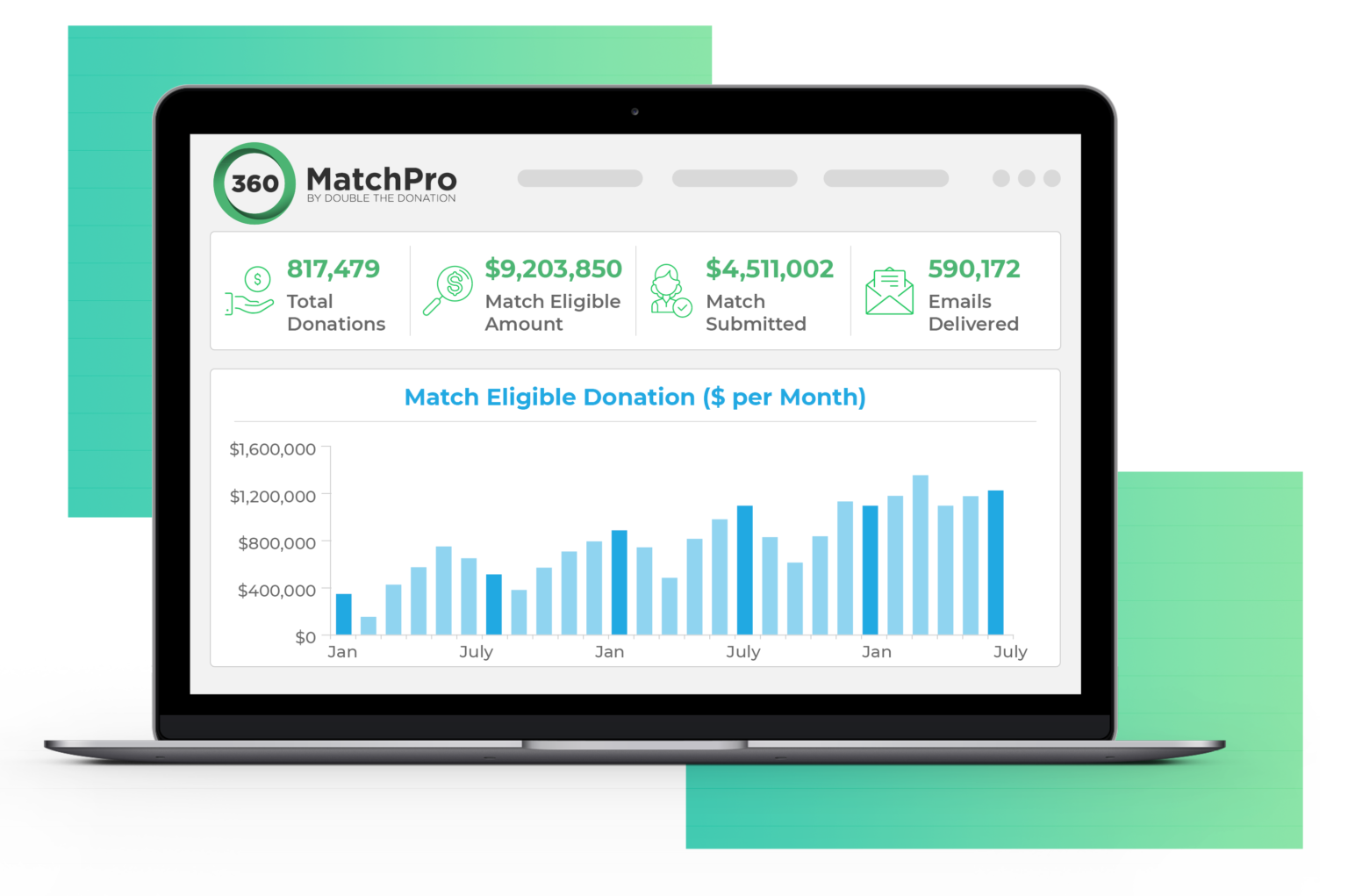Collect These 8 Pieces of Donor Data to Fuel Fundraising Success

The more an organization knows about its donors, the better it can connect with the individuals funding its mission.
Studies show that $4 to $7 billion in matching gift funding goes unclaimed each year. This significant gap can largely be attributed to a lack of awareness of employer match opportunities among donors and donors’ eligibility status among nonprofits.
Having the right donor data can help nonprofits avoid this collective lack of awareness by identifying and pursuing eligible matches. Here are eight examples of data points you can collect from donors to get you started:
- Contact information
- Engagement history
- Employing company
- Type of employment
- Job title
- Matching gift eligibility
- Wealth level
- Hobbies and interests
You likely won’t have the time or resources to collect all of this information for every donor, but it should be a goal to gather as much data as possible for optimal fundraising practices.
Not only will the right donor insights enable you to maximize matching gift strategies, but it will also position your nonprofit to engage with your supporters in the right ways at the right times.
Contact Information
Needless to say, you need donors’ contact information to get in touch with them and to thank them for their support. Not to mention, you’d be unable to inform them about matching gift opportunities or follow up with future appeals.
For this reason, organizations typically require donors to complete particular contact fields during the online giving process. These fields often include their names and email addresses. Many request telephone numbers as well, along with mailing addresses.
It’s important to note that requiring too much information can slow the donor down and lead to donation form abandonment. Avoid this by identifying which pieces of donor information are most valuable to your outreach strategy.
Engagement History
Sending tailored communications to your donors based on their involvement with your cause helps build a deeper sense of trust and connection.
When you have a record of an individual’s engagement history with your organization, you can strategically target your messaging to produce highly specific and personalized content. Here are a few prompts to consider when conducting donor outreach:
- Are they first-time or returning donors?
- Have they attended a recent fundraising event?
- Have they donated time as a volunteer with your cause?
- Have they submitted a match request on behalf of your cause?
Knowing who has given to your organization in the past and how much each individual donated can play a significant role in determining if those gifts are eligible for corporate matches.It’s also important to keep tabs on donors who have provided corporate matches in the past to re-engage for future campaigns.
Luckily, this piece of donor data should be fairly easy to locate within your organization’s constituent relationship management system (CRM). As supporters travel through the various phases of their donor journeys, this technology enables you to maintain clean, accurate donor records to draw data from in the future.
Employing Company
Do you know which companies your donors work for? What industries they’re involved with? Are they employed by small local businesses or enterprise-level corporations?
Knowing the answers to these questions can help your team identify potential corporate sponsorships, matching gift opportunities, and cause marketing partnerships.
If you don’t have your donors’ employer information on record, there are several avenues you can take to locate the data. For example, employer-appending services utilize the information you do have about your donors (like name and contact information) to help fill in the gaps. Additionally, processes such as automated or manual prospect research, email domain screening, and matching gift search widgets can provide valuable insights as well.
Type of Employment
Let’s say you determined through data collection that a major donor is employed part-time by Company A. You know from past experience that Company A has a particularly generous employee matching gift program. After digging, you discover that they’ll only match donations made by current full-time employees (rather than part-time team members, retirees, or spouses). Since this individual is not a full-time worker, their donation won’t be eligible for a corporate match.
That example shows why employment type is an essential piece of donor data to collect, rather than settling for just the name of their employer.
In terms of workplace giving, there are four categories of individuals who may be eligible to request a match from a company. These include:
- Current full-time employees
- Current part-time employees
- Retired full-time employees
- Employees’ spouses
Current full-time team members are typically match-eligible by any company with a matching gift program. The eligibility of part-time staff, retirees, and spouses, on the other hand, depends on the specific company running the giving program.
Job Title
Once you’ve narrowed your donor’s employment down to the company they work for and their type of employment, collecting their job title is another piece of information that can help inform your outreach.
While a donor’s job title won’t typically impact their eligibility status for a workplace giving program, it can provide insights into their role and level of seniority and help establish potential wealth markers.
For example, the CEO of Company A will typically have more connection opportunities and a greater capacity to give than an entry-level junior marketing assistant. Still, both individuals might have the potential to be excellent donors. It’s just another piece of information that can help guide your team as you develop communication and engagement strategies.
Matching Gift Eligibility
Once you know the companies your donors work for, it’s significantly easier to determine which supporters (and their gifts) might be eligible for a corporate match.
Do your donors work for any of these top matching gift companies?
- General Electric (1:1 match between $25 and $5,000)
- Disney (1:1 match between $25 and $5,000)
- Coca-Cola (2:1 match between $25 and $20,000)
- Soros Fund Management (Up to 2:1 match between $25 and $100,000)
- Johnson & Johnson (Up to 2:1 match between $25 and $20,000)
In addition to this list, there are a ton of other businesses, small and large, that offer generous and impactful employee matching programs.
To identify these additional companies, we suggest using a matching gift database. This comprehensive database tool equips donors and fundraisers alike with insights on thousands of companies’ matching gift programs.
Beyond the individual’s type of employment—which is likely a key factor in their eligibility—a robust database can also provide details on qualifying nonprofit causes and minimum and maximum donation amounts to further vet whether a specific gift is going to be matchable.
Income Level
Picture this: Donor A visits your campaign page with the intent to make a $50 donation. When they arrive, they see suggested gift amounts of $250, $500, and $1,000. Donor A immediately decides that their initial $50 gift is inconsequential compared to the recommended amounts and opts to forego giving altogether.
On the other hand, imagine that Donor B has the potential to contribute $25,000 to your cause. When they see $1,000 as the highest suggested donation amount, they reconsider their major gift and simply check the pre-filled box for $1,000 instead, though their capacity to give was so much greater.
This demonstrates the importance of understanding your donors’ wealth levels as you begin crafting your donation appeals. If you run into a situation where a donor wants to contribute more but doesn’t have the financial means, take advantage of the opportunity to explain matching gifts and work together to identify if their company offers a matching gift program. Suddenly, the donor can make an even bigger contribution to your cause.
Hobbies and Interests
Your donors’ hobbies and interests are additional pieces of data that can help you build a more well-rounded understanding of each individual. It can also help you connect them to certain opportunities within your organization that they’d enjoy.
If you run a local animal shelter and know that a particular donor is a cat-lover, you can include photos of your shelter’s cutest cats in all email appeals, postcards, and thank-you notes. You could specifically target that donor with any donation requests that directly support the cats at your shelter, or even invite them to spend an afternoon playing with the cats. When they get more involved behind the scenes, you can establish a deeper sense of connection.
While knowing seemingly trivial details about your donors can seem insignificant, it can make a big difference when looking to establish personal and long-term relationships with supporters. Plus, you can ensure your fundraising communications stand out from the crowd.
Next Steps: Applying Donor Data for Nonprofits
When it comes to driving workplace giving and other fundraising revenue, having ample and accurate employment data is key. And, in order to keep track of all the information you collect, you’ll need a robust CRM and donation management solution.
Make sure to equip your nonprofit team with the right tools so that you can collect the right donor data and better engage with your audience. In the end, you’ll see deeper donor relationships beyond the surface level, and have additional opportunities for corporate matching gifts.

See How Double the Donation Works with Classy



